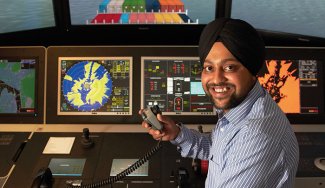

Why choose this course?
Get qualified for a maritime career working as a master or chief mate on vessels less than 500 gross tonnage. During this course you will experience fighting fires in simulated environments, practicing in-water survival skills and rescuing others in distress. You will also learn how to tie seaman’s knots and hitches to ships in rough waters.
This course will develop your leadership capability to lead and manage a crew on any size vessel. You will gain the skills to instruct the ship's crew on watchkeeping, wheelhouse operations, environmental management, routine maintenance, record keeping and logbooks, communications and stability.
On successful completion of this course you will be able to perform the duties or functions of:
- a master on vessels less than 24 metres (foreign going);
- a chief mate on vessels with less than 3000 gross tonnage (GT);
- a master of commercial vessels with less than 500 gross tonnage (GT); and
- a mate on vessels with less than 500 gross tonnage (GT).
Please note the Maritime calendar differs from the standard TAFE WA semester calendar. Semester dates are stated in your Letter of Offer.
This course is a full-time program that is timetabled over 4 to 5 days per week. This means you will have a very heavy study load which will encroach on your personal commitments during weekdays over the course of the program. The timetabled hours per week are essential to ensure all course requirements are met.
Career opportunities
- Ship's Master
When choosing a course, it's important to think about the key skills and knowledge you'll need, as well as how you'll be assessed. Take a look at this information and consider if you might face any challenges in meeting the course expectations and requirements.
- good time management and the ability to work with tight deadlines
- ability to strictly follow workplace safety standards
- a keen eye for detail
- logical problem solving skills
- good communication skills
- a strong interest in boats, ships and maritime
-
An IELTS score (Academic) of 6.0 with no band score less than 6.0 or equivalent.
-
Equivalent to Australian Year 12.
-
Students must have 36 months of sea time to achieve AMSA certification requirements. Please refer to regulatory requirements licensing information listed under additional information.
-
Students must submit a comprehensive Resume outlining their work experiences, employment history and qualifications in order for the application to be assessed for entry into this course.
Legislative and regulatory requirements are applicable to this qualification. This qualification meets some of the requirements to obtain an AMSA certificate of competency as a Master of a commercial vessel less than 500 GT as defined in Marine Orders and STCW.
AMSA certification of competency will require:
- completing an approved program of study that meets regulations STCW A-II/1 and A-II/2 (MAR50320 Diploma of Maritime Operations - Masters less than 500 GT)
- holding or have held certificates of competency as defined in Marine Order 71
- qualifying sea service as defined in Marine Order 71
- completing STCW short courses as defined in Marine Order 71
- holding a valid AMSA certificate of medical fitness
- having passed a final AMSA assessment
- meeting any other regulatory requirements as defined in Marine Order 71
Seafarers seeking certification should check requirements with AMSA.
There may be further semester intakes available for enrolment. You can view any further intakes when you submit your online application(opens in a new tab).
For information about pathways from TAFE to university, view our Pathways to university page.
How to apply
Apply to study at TAFE in six steps:
- find a course;
- check entry requirements;
- submit an application;
- accept your offer and pay;
- apply for your student visa; and
- receive your visa and come to Australia for your studies.
Build your own course guide
Select the study areas, courses and topics you like. Get your custom guide by email!
Download study area guide(opens in a new tab)
Contact us(opens in a new tab)
TAFE International Western Australia (TIWA) is the Registered Training Organisation (RTO) and Commonwealth Register of Institutions and Courses for Overseas Students (CRICOS) provider, for the delivery of training to international students, enrolled in a TAFE course in Western Australia. This nationally recognised course is delivered by a Western Australian TAFE college on TIWA's behalf. TIWA retains responsibility for the quality of the training and assessment delivered by the TAFE colleges and for the issue of certification documentation to students.


